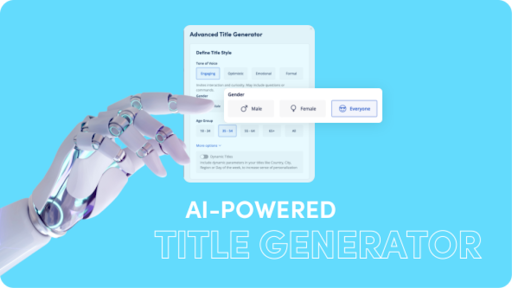How to Do Marketing for Real Estate? 14 Ideas to Boost Your Business

Some properties fly off the market while others sit there and stagnate. Why is that? It’s all about marketing for real estate.
While property staging (how it’s presented) is important, how well the real estate agent or property developer markets the property is an even bigger factor in success.
In other words, it depends on the quality of your marketing.
As marketing legend Seth Godin puts it, “People do not buy goods and services. They buy relations, stories, and magic.”
In this guide, we’ll explore 14 real estate marketing ideas to create the magic you need.
Marketing for Real Estate: 14 Tactics to Try
1. Create an Ideal Customer Profile
The golden rule of marketing is to know who you are trying to attract before you do anything else.
In real estate, this means knowing what type of buyer you’re looking for.
- Are they professional property developers or private buyers?
- What type of properties are they looking for?
- How much money do they have available to spend?
- Which locations are they interested in?
Once you understand who you’re targeting, you can build your marketing around the different groups.
For instance, if you’re looking for young professionals who want to buy their first home, then you should promote small family homes in commuter areas. If you’re targeting retirees, then single-story homes or apartments near towns might be best.
2. Use Real Estate Digital Platforms
Depending where in the world you’re based, there are various online real estate platforms that allow you to list your properties and present them to potential buyers. Below you’ll find the most popular platforms by region.
United States
- Zillow: Probably the most well-known for buying, selling, and renting properties.
- Realtor.com: Offers comprehensive real estate listings and connects users with local agents.
- Trulia: Known for detailed property listings and neighborhood insights.
United Kingdom
- Rightmove: The UK’s largest property portal, used extensively for buying and renting properties.
- Zoopla: Offers extensive listings and property value information.
- OnTheMarket: Known for providing listings directly from real estate agents.
Europe
- ImmobilienScout24: One of the leading property platforms in Germany.
- Idealista (Spain, Italy, Portugal): Popular in Southern Europe for buying, selling, and renting homes.
- Funda (Netherlands): The top site for Dutch property listings, offering extensive details on properties.
Middle East
- Bayut: Biggest platform in the UAE, offering full listings for buying and renting properties.
- Property Finder: Widely used across the UAE and other Middle Eastern countries for real estate searches.
- Zameen: The leading real estate website in Pakistan, covering sales and rentals.
Asia
- 99acres: One of India’s largest platforms for buying, selling, and renting properties.
- PropertyGuru: Popular in Singapore, Malaysia, Thailand, and Indonesia, offering extensive real estate listings.
- MagicBricks: Another major platform in India known for its wide range of property listings and related services.
Most of these platforms are straightforward to use. You simply register your details, get verified, then start listing properties.
When you’re listing properties on these platforms, make sure that you use high-quality photos with good lighting. If you can afford it, hire a professional photographer to make your properties look warm and welcoming.
Another good way to attract buyers is to use virtual tours and video walkthroughs. You can buy or hire a 3D scanning camera, such as Matterport, to create immersive 3D tours. These are great as people can click through to different rooms and look around in all directions. It gives a real sense of the space, layout, and feel of the property before viewing it in person.
If you want to add a real “wow factor”, include aerial photos or video footage of the property and surrounding land, using a drone. There are plenty of companies out there that sell FAA-approved drone services these days, such as HouseLens and SoldByAir.
Don’t forget to spend a bit of time writing clear and engaging descriptions. Try to highlight what makes each property special, such as a recently refitted kitchen, large garden space, or amazing views. You want to aim for persuasive text, but not too pushy or salesy, as this can put people off. Include floor-plans too, if available.
Address any concerns people might have by mentioning potential drawbacks directly and honestly. For example, if a house is in a busy area, highlight the convenience of nearby amenities and transport links, turning a possible negative into a positive.
Finally, make sure you always respond quickly to inquiries. People often reach out to multiple listings at once these days, so the faster you respond, the more likely you are to get a sale.
3. Build Your Online Presence
In addition to listing your properties on digital platforms, you should also look to build your own online presence, especially if you’re a real estate agency that’s looking to grow.
The first thing to do is build a professional website that looks good, is easy to navigate, and is full of high-quality and useful content. You also need to make sure it is optimized for all devices, especially smartphones. Today, 74% of homebuyers search for real estate on mobile, making mobile the most popular device for property hunting.
Building your website might seem like a big and daunting task, but you can hire people through freelancing platforms to do it all for you at a reasonable price.
Once your website is up and running, make sure it is all indexed properly on Google search listings (again, you can hire a freelancer to help with this if needed) and also set up a local Google Business Profile that will get shown on Google Maps. It also means that you’ll show up near the top of the listings when people search for real estate agencies in your area.
4. Gain Social Media Followers
Building a social media following gives you a big edge over competitors, as it gives you more visibility. The more followers you have, the more eyes you get on your property listings. Every time you post a new house or apartment, you’re potentially reaching thousands of people, and not just any people – these are people who’ve already shown interest in your content, so they’re more likely to be engaged.
Having a strong presence on social media also helps to build credibility, as it shows you have already established trust within your community. You can also interact with potential buyers, sellers, and renters. This gives you insights into what they’re looking for and forge relationships with people.
Facebook and Instagram are the best to focus on for real estate agents, as they cover a broad demographic and are perfect for sharing photos, videos, and detailed posts about properties. You can also run highly targeted ads on these platforms using Meta Ads.
You might also want to consider starting a YouTube channel, especially if you’re using a lot of video in your real estate marketing. You can post full virtual tours, detailed client testimonials, and educational content that helps buyers and sellers navigate the real estate process.
Another good social media real estate marketing idea is to collaborate with local businesses or influencers with a large local following. This introduces your properties to an audience that trusts their recommendations. You could co-host virtual open houses, feature listings on their channels, or even take part in local community events together.
5. Use Content Marketing for Real Estate
According to research, content marketing costs 62% less than other marketing techniques and results in three times as many leads. Sharing useful content about homebuying, finding mortgages, renovating homes, and other relevant topics will bring in real estate leads.
First, brainstorm ideas for blog content that your target audience will find interesting and useful. You can use common search terms as a starting point. Here are a few examples to get your creative juices flowing.
- How To Find The Best Mortgage Rate for You
- 7 Things To Look Out for When Buying Your First Home
- 10 Tips for Staging Your Home to Sell Quickly
- How to Choose the Right Real Estate Agent for You
- Top 5 Mistakes to Avoid When Selling Your Home
- The Pros and Cons of Buying a Fixer-Upper
- How to Win in a Competitive Housing Market
- The Best Time of Year to Buy or Sell a Home
- The Ultimate Guide To Home Inspections
- What to Expect When Moving to a New City
- How to Maximize Your Home’s Curb Appeal
When writing blog content, you should aim to include SEO keywords, but don’t overstuff articles with them as it can work against you if Google’s algorithms pick it up. To find the best keywords, use tools such as Google Ads Keyword Planner, SurferSEO, or ahrefs.
The most important thing to pay attention to is readability and value. Google and other search engines reward content that people engage with, which means they spend time scrolling through your blog post. If they click away in the first few seconds, this leads to a high “bounce rate”, which will negatively impact your search results.
Your broader real estate content marketing strategy should aim to position you as an expert. To do this, think about setting up a YouTube channel or launching a podcast, as well a blog. You can also guest post on high authority sites or try to book appearances on other people’s channels. Below, you’ll find a list of the top real estate YouTube channels for inspiration.
6. Run Paid Ad Campaigns
Digital Ads
PPC (pay-per-click) ads are ideal for real estate, enabling you to advertise on a wide range of online platforms, such as Google search, Google display, or social media, and only pay when someone clicks on your ad.
The costs vary widely depending on keyword competition and geographic targeting. For real estate, you might pay a few dollars per click in some markets, but it can go much higher in ultra-competitive areas.
Display ads or banner ads are great for short-term campaigns, quickly reaching targeted audiences with properties that are available right now. You can target by location, interests, and even user behavior, which means you can get your real estate offers in front of the right people.
Native ads are an excellent way to nurture potential real estate buyers while they browse online. Unlike display ads that stick out and disrupt the online experience, native ads are designed to fit naturally with the web page they are displayed on, so they don’t feel like ads. That’s why native ads vs display ads generate more viewability and brand uplift.
You can use native ads to promote content about home buying or properties for sale, driving traffic to your website. With native video ads, you can promote video clips from available properties and target highly relevant audiences. You can also use the native carousel format to present a range of properties in one ad, creating an engaging experience for the potential buyer. Outbrain’s wide range of ad formats enable real estate marketers to create unique and exciting campaigns that get results.
Traditional Ads
Don’t count out traditional ads like newspaper ads, billboards, or mailers. They’re still good for reaching local audiences or older buyers who might not be as active online. Costs vary, with a billboard in a busy part of town costing a lot more than a newspaper ad in a small community paper. Both have their advantages depending on who you’re trying to reach.
Combining both digital and traditional ads is ideal. For example, you can run PPC ads to attract online buyers, with a well-placed billboard to catch the eye of local traffic. This multi-channel approach ensures you don’t miss out on potential buyers, wherever they might be.
7. Build an Email List
Email marketing is perfect for real estate, as you can send out property listings as soon as they’re available to a hungry market. A good way to build an email list is to use a capture form on your website content, promising subscribers an exclusive first look at listings.
You can also use a “lead magnet”, a piece of gated content that people exchange their email address to download. For example, you can create an e-book that provides information about different residential areas of a particular city, to help people decide where they might want to buy their next home. In order to receive the online guide, the person must provide their name and email address. Voila! You’ve just added another potential customer to your email marketing list.
Once you have built an email list, keep them engaged by sending out weekly or monthly newsletters, property listings, and listing roundups. The idea is to keep your real estate agency on their radar, so when they’re ready to buy a property, they’ll come to you.
It’s good practice to segment your email list if possible, which means having different lists for different buyer types. For example, you might have segments for first-time homebuyers, luxury property investors, commercial property clients, and rental seekers. Segmented campaigns have been shown to drive a 760% revenue increase for businesses.
8. Monitor and Adjust
Google Analytics helps you understand how people interact with your website. It shows you what pages they visit the most, how long they stay, and what content drives them to reach out. Ad networks like Outbrain provide in-depth data about campaign performance, so you can see what works with your target audience and optimize future campaigns to get better results.
You can also use analytics from social media platforms, such as Facebook Insights or Instagram Analytics. These tools give you a breakdown of your audience, what posts they engage with the most, and the best times to reach them.
Use this data to stay responsive and tweak your strategies. For example, if you notice that native video ads promoting virtual tours of properties are getting a lot of attention, make more of those. Use A/B testing to test different ad elements and see which images and headlines perform best. If an ad isn’t working well, then adjust the imagery, copy, or targeting criteria.
9. Host Special Events
Virtual events or webinars broaden your reach beyond local boundaries, as potential buyers or investors can tune in from anywhere in the world. Consider running webinars on the latest real estate trends or market analyses to show your expertise and engage potential buyers.
Virtual property tours let you show your properties to clients who can’t visit in person due to distance or time constraints. A virtual open house gives a real-time tour of the property and highlights its features.
You can also answer questions with virtual Q&A sessions. This kind of direct engagement builds relationships and gives you insights into what clients want, so you can tailor future offerings.
10. Invest in Branded Goods
The most obvious branded item is the humble business card, but don’t go for any old card. Try an innovative approach, like including a QR code that links directly to your listings or contact info.
Branded swag is another way to get your agency name out there. Small items like keychains, pens, or even tote bags with your agency’s logo on them are fairly inexpensive. Every time someone uses one of those items, it’s free advertising. People love free stuff, especially when it’s something useful, so it also builds a positive sense of connection.
For higher-end clients, you might consider more premium items like branded umbrellas, high-quality notebooks, or even tech gadgets.
11. Get Reviews, Testimonials, and Referrals
Good reviews and testimonials are the lifeblood of any service business, including real estate agencies. Don’t shy away from asking for reviews directly. After closing a deal, ask your clients if they wouldn’t mind writing a quick review on platforms like Yelp, Google, or TrustPilot. People are often happy to do it, especially if they’re pleased with the service you delivered.
Testimonials are a bit more in-depth, but really show others what it’s like to work with you. Ask clients if they’d be willing to provide a testimonial for your website or social media. Video testimonials are gold because they’re more personal and engaging. The best approach is to film a quick interview with clients after they’ve bought or sold a property through you.
Referrals are great for business too. Ask your clients to refer others by offering something valuable, like a gift card or a discount on a partner service, such as home cleaning or renovation. Make it a win-win situation for people, and you’ll see your referral network grow.
12. Offer Free Services
When you list a property, offer free staging advice or give a few tips on how to make the listing more appealing. This isn’t just about being ‘nice’, it’s also strategic. A well-presented home sells faster and often for a higher price. Providing free staging support is a plus when potential sellers consider which agent to choose.
You may wanto to offer free home valuations for potential sellers. Don’t forget to provide useful content for free too, such as a moving day checklist for buyers. Use your social media platforms and partner sites to announce and promote these free services and giveaways. Social media is perfect for quick, visual promotions, such as posting before-and-after staging photos or sharing snapshots of happy clients in their new home.
13. Embrace Sustainable and Eco-Friendly Initiatives
There’s a growing trend towards sustainability in housing. More and more buyers are looking for homes that are comfortable, beautiful, and environmentally friendly. This means energy-efficient appliances, solar panels, sustainable building materials, and smart home technologies that reduce energy use. Remember to promote these features in your property listings, in native ad campaigns, and on social media.
14. Run Co-Marketing Campaigns with Other Local Businesses
Co-marketing campaigns with local businesses and organizations help connect you with the wider community. Sponsoring local sports teams or school events is a great way to get your name out there. This creates a positive image and builds trust, which is essential in real estate.
Partnering with local businesses like retail stores or moving companies is another smart move. For example, you can team up with furniture stores to stage homes you’re selling. This makes the properties look amazing and gives the furniture stores exposure to potential buyers.
You can also offer discounts for moving companies. When you help each other out, both businesses get a boost.
Hosting joint events is another great co-marketing strategy. It could be something like a neighborhood open house or a seminar on home-buying tips, where you bring in a local mortgage expert.
Make a Real Impact with Your Real Estate Marketing
Marketing your real estate business is all about defining your target market, then making sure your messaging speaks to those people. There are plenty of real estate platforms out there to list your properties. Use 3D tours and good photography to make your listings stand out.
Social media engagement is another good way to reach people online, especially if you can tie it in with local community involvement and partnerships.
Native advertising is a powerful strategy that real estate professionals can use to reach potential buyers while searching for properties online. With Outbrain’s advanced targeting methods, you can be sure you are reaching high-quality traffic, which brings more qualified leads.




















